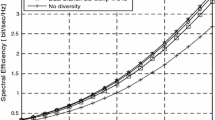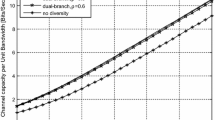Abstract
The channel capacity and probability of outage results for optimum power and rate adaptation (OPRA) and truncated channel inversion with fixed rate (TIFR) schemes over correlated diversity branch obtained so far in literature are applicable only for m ≥ 1. This paper derived closed-form expressions for the average channel capacity and probability of outage of dual-branch maximal ratio combining (MRC) over correlated Nakagami-0.5 (m < 1) fading channels. This channel capacity and probability of outage are evaluated under OPRA and TIFR schemes. Since, the capacity and probability of outage expressions of dual-branch MRC under OPRA and TIFR schemes contain an infinite series; bounds on the errors resulting from truncating the infinite series have been derived for both average channel capacity and probability of outage. The corresponding expressions for Nakagami-0.5 fading are called expressions under worst fading condition with severe fading. Finally, numerical results are presented, which are then compared to the capacity and probability of outage results that previously published for OPRA and TIFR schemes. It has been observed that OPRA provides improved average channel capacity and probability of outage, as compared to TIFR under worst case of fading. It is also observed that probability of outage under TIFR scheme is not improved adequately than the probability of outage under OPRA even as employing diversity.










Similar content being viewed by others
References
Khatalin, S., & Fonseka, J. P. (2007). Channel Capacity of dual- branch diversity systems over correlated Nakagami-m fading with channel inversion and fixed rate transmission scheme. IET Communications, 1(6), 1161–1169.
Khatalin, S., & Fonseka, J. P. (2006). Capacity of correlated Nakagami-m fading channels with diversity combining techniques. IEEE Transactions on Vehicular Technology, 55(1), 142–150.
Goldsmith, A. J., & Varaiya, P. P. (1997). Capacity of fading channels with channel side information. IEEE Transactions on Information Theory, 43(6), 1986–1992.
Alouini, M.S., & Goldsmith, A.J. (1997). Capacity of Nakagami multipath fading channels. Proceedings of the IEEE Vehicular Technology Conference, Phoenix, AZ, pp. 358–362.
Alouini, M. S., & Goldsmith, A. J. (1999). Capacity of Rayleigh fading channels under different adaptive transmission and diversity-combining techniques. IEEE Transactions on Vehicular Technology, 48(4), 1165–1181.
Bithas, P. S., & Mathiopoulos, P. T. (2009). Capacity of correlated generalized gamma fading with dual-branch selection diversity. IEEE Transactions on Vehicular Technology, 58(9), 5258–5263.
Alouini, M. S., & Goldsmith, A. (2000). Adaptive modulation over Nakagami fading channels. Wireless Presonal Communication, 13, 119–143.
Subadar, R., & Sahu, P.R. (2009). Capacity analysis of dual-SC and-MRC systems over correlated Hoyt fading channels, IEEE Conference, TENCON-2009, pp. 1–5.
Hamdi, K. A. (2008). Capacity of MRC on correlated Rician fading channels. IEEE Transactions on Communications, 56(5), 708–711.
Khatalin, S., & Fonseka, J. P. (2006). On the channel capacity in Rician and Hoyt fading environment with MRC diversity. IEEE Transactions on Vehicular Technology, 55(1), 137–141.
Hasan, M. I., & Kumar, S. (2014). Channel capacity of dual-branch maximal ratio combining under worst case of fading scenario. WSEAS Transactions on Communications, 13, 162–170.
Brennan, D. (2003). Linear diversity combining techniques. Proceedings of the IEEE, 91(2), 331–354.
Simon, M. K., & Alouini, M. S. (2005). Digital communication over fading channels. New York: Wiley.
Gradshteyn, I. S., & Ryzhik, I. M. (2000). Table of integrals, series, and products. New York: Academic Press.
Wolfram, The Wolfram functions site (2014), Internet (online). http://functions.wolfram.com.
Author information
Authors and Affiliations
Corresponding author
Rights and permissions
About this article
Cite this article
Hasan, M.I., Kumar, S. Average Channel Capacity of Correlated Dual-Branch Maximal Ratio Combining Under Worst Case of Fading Scenario. Wireless Pers Commun 83, 2623–2646 (2015). https://doi.org/10.1007/s11277-015-2559-z
Published:
Issue Date:
DOI: https://doi.org/10.1007/s11277-015-2559-z




